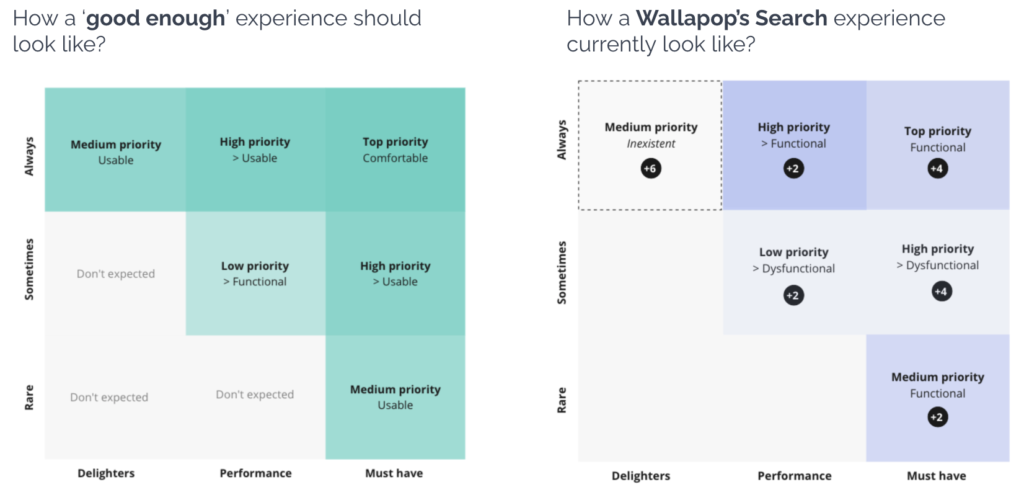In the context of Wallapop’s Buyer tribe, the Search Experience (Search XP) and Search teams were operating with distinct and sometimes conflicting goals. This lack of alignment created fragmented user experiences and slowed progress toward a cohesive and impactful search journey. To address this, I led an initiative to establish a shared vision for what constitutes a “good-enough” search experience. The goal was to align the teams with shared objectives, create clear prioritization frameworks, and influence their roadmaps, all while maintaining a strong focus on user needs and business goals.
Goals
As the Design Manager of the Buyer Tribe, I spearheaded this initiative in collaboration with the Head of Product and a UX Researcher. I took ownership of defining the frameworks, building the tools necessary to prioritize initiatives, and facilitating a workshop to align the Search XP and Search teams. My role extended beyond facilitation, ensuring that design had a strong voice in shaping the shared vision and influencing key decisions.
- Define a shared vision: Establish a baseline for what constitutes a “good enough” search experience.
- Align teams: Create shared goals to bridge the gap between the Search XP and Search teams.
- Prioritize effectively: Develop frameworks and tools to ensure roadmap alignment and clear prioritization.
- Empower collaboration: Foster a culture of shared ownership and influence across both teams.
Frameworks and Tools
The success of this initiative hinged on the development of a robust prioritization framework that included:
Quality Scale
A hierarchical scale categorizing experiences from “Dysfunctional” to “Delightful.”

Prioritization Matrix

- Frequency Axis:
- Always: Features users must interact with in every search (e.g., keyword input).
- Sometimes: Features used less frequently but still essential for success.
- Rare: Features users seldom engage with.
- Criticality Axis (Kano Model):
- Delighters: Features that pleasantly surprise users and enhance satisfaction.
- Performers: Features users actively want and expect.
- Must-Haves: Basic features required to meet user expectations.
Targeting Progression
Introduced progressive targeting to ensure focus on foundational (“Good enough”) experiences before advancing to “Enhanced” and “Delighting” experiences.

As goal for the year we had close the gap within our experiences we started looking into first target (good enough) and compared our search experience to thosw targets.

Execution
To operationalize the frameworks, I partnered with the Head of Product and a UX Researcher. Together, we organized a workshop that brought both teams together.
Preparation

Key steps:
- Conducted initial research to identify pain points in the search experience.
- Build a list of features of the Search XP and gather user impact about their criticality.
- We defined quality targets for each functionality based on Framework.
Workshop

Key steps:
- Engaged teams in interactive discussions to evaluate current functionalities.
- Facilitated exercises to classify features using the prioritization framework.
- Guided teams in mapping existing features onto the quality scale.
Outcomes
Unified Vision
Both teams aligned around a common definition of a “good enough” search experience.

Shared Goals
Roadmaps for the Search XP and Search teams were synchronized, reducing redundancies and improving collaboration.


Prioritized Roadmap
High-priority features identified and accelerated for development. Clear progression from foundational to enhanced experiences.

Impact
- Efficiency Gains: Reduced overlap between teams, saving time and resources.
- User Satisfaction: Established clear priorities to address pain points and improve search functionality.
- Scalability: Built a framework that can be reused for future cross-team initiatives.
Key Learnings
- Collaboration is Key: Bringing teams together early fosters alignment and accelerates execution.
- Frameworks Drive Clarity: Tools like the prioritization matrix and quality scale provide a clear structure for decision-making.
- Foundation First: Building a “good enough” baseline is essential before aiming for delight and differentiation.
This project demonstrates the power of strategic design leadership in aligning teams and driving impactful outcomes through shared vision and clear prioritization.
